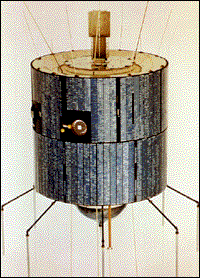ATS-3

ATS-3 prelaunch
|
|
| Mission type |
Weather Communications Technology |
|---|---|
| Operator | NASA |
| COSPAR ID | 1967-111A |
| SATCAT no. | 3029 |
| Mission duration | 3 years planned |
| Spacecraft properties | |
| Bus | HS-306 |
| Manufacturer | Hughes |
| Launch mass | 365.0 kilograms (804.7 lb) |
| Start of mission | |
| Launch date | November 5, 1967, 23:37:00 UTC |
| Rocket | Atlas SLV-3 Agena-D |
| Launch site | Cape Canaveral LC-12 |
| Orbital parameters | |
| Reference system | Geocentric |
| Regime | GSO |
| Semi-major axis | 42,241.0 kilometres (26,247.3 mi) |
| Eccentricity | 0.00043 |
| Perigee | 35,723 kilometers (22,197 mi) |
| Apogee | 35,862 kilometers (22,284 mi) |
| Inclination | 6.92 degrees |
| Period | 23.93 hours |
| Epoch | January 21, 2014, 11:54:19 UTC |
Applications Technology Satellite 3, or ATS-3, was a long-lived American experimental geostationary weather and communications satellite, operated by NASA from 1967 to 2001. It was at one time reputed to be the oldest satellite still in operation; As of 1995[update], NASA referred to the ATS-3 as "The oldest active communications satellite by a wide margin."
On November 10, 1967, ATS-3 took the first color photo of the Earth, which was subsequently used on the cover of the first Whole Earth Catalog.
Launched in November 1967, the ATS-3 was in service for 11 years before finally being decommissioned in 1978 along with ATS-1. Among its widest-known achievements are the first full-disk, color Earth images transmitted from a satellite. Its imaging capability has served during disaster situations, from the Mexico earthquake to the Mount St. Helens eruption.
ATS-3 experiments included VHF and C-band communications, a color spin-scan camera (principally developed by Verner E. Suomi), an image dissector camera, a mechanically despun antenna, resistojet thrusters, hydrazine propulsion, optical surface experiments, and the measurement of the electron content of the ionosphere and magnetosphere.
Because of failures in the hydrogen peroxide systems on ATS-1, ATS-3 was equipped with a hydrazine propulsion system. Its success led to its incorporation on ATS-4 and ATS-5 as the sole propulsion system.
The satellite is in geo-synchronous orbit 34,047 kilometers (21,156 mi) above the Earth's surface. The satellite has served as a communications link for rescue operations, including the 1985 Mexico City earthquake and the 1980 eruption of Mount St. Helens.
...
Wikipedia
